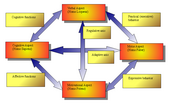
The hypostatic model of personality is a view asserting that humans present themselves in many different aspects or hypostases, depending on the internal and external realities they relate to, including different approaches to the study of personality. It is both a dimensional model and an aspect theory, in the sense of the concept of multiplicity. The model falls into the category of complex, biopsychosocial approaches to personality.
The term hypostasis can cover a wide range of personality-related entities usually known as type, stage, trait, system, approach.[1] The history of the concept can be traced back to Peirce's hypostatic abstraction, or personification of traits. Different authors have described various dimensions of the self (or selves), personality dimensions and subpersonalities.[2] Contemporary studies link different aspects of personality to specific biological, social, and environmental factors.
The work on subpersonalities[2] was integrated into a hypostatic model.[3] The model describes personality aspects and dimensions, as well as intra- and interpersonal relations. Not the person whole and alone, nor the relationship, but the relation between parts of person(s) is held as a central element that promotes both personal and social organization and disorganization. Personality is viewed as both an agency and a construction, along with its development and psychopathology, as the model is accompanied by specific methods of assessment and therapy, addressing each of the personality dimensions. The hypostatic relations of the human mind also imply the existence of a hypostatic model of consciousness, representing the contents of consciousness as an identity of various aspects, different only with respect to each other, but tending to coincide in a certain aspect of their consideration.[4]
